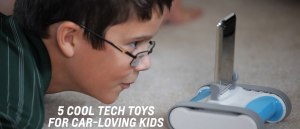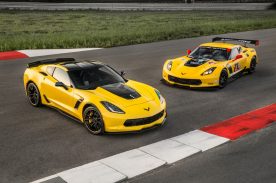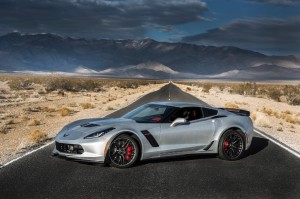Author Archives: greggardnergm
Charles Mallon owns 2,014 Corvettes, and only one is in his garage.
By Stephen Williams
Of the hundreds of thousands of automotive enthusiasts around the world who worship at the altar of the sports car, very few can claim ownership of 2,014 Chevrolet Corvettes.
That’s 2,013 in Charles Mallon’s basement—contained in a display case and dozens of tote bags—and one in his garage: a 2005 LeMans blue C6.
One real Corvette is just enough for Charles Mallon.
Turning a hobby into a quest for a spot in the Guinness Book of World Records isn’t something one plans overnight. Indeed, Mallon has accomplished just that. In June, he was certified by the Guinness folks for having the “Largest Collection of Chevrolet Memorabilia.”
He can trace back his affection for the marque to the age of 2, when, his mother tells him, he “could pick out a Corvette in a crowd, and run right over to it.”
Mallon’s Corvette-mania extends beyond just the miniature car models: He’s been assembling all bits of Chevy memorabilia since he was 14, from signs and books and posters to soda cans and Chevy belts. But his heart lies with the car.
“I started serious collection when I was 14,” he says. “I would bring home three models, then five models, and you get carried away. I’m into cars of all shapes and sizes, but growing up it was probably the look and the sound of the Corvette. It’s America’s sports car.”
Now 54 and a consultant working with auto dealerships on facility improvements, Mallon—who’s lived in Pennsylvania, near Philadelphia, all his life—still enlists friends to seek out Corvette miniatures on their visits to toy stores and flea markets. About 600, ranging in size from a few centimeters to more than a foot, reside in that display case in Mallon’s basement, and the rest are packed away in tote bags, “rotated on display periodically,” he says. Mallon’s wife, Gina, is particularly good-natured about the whole thing. “That’s his man-cave downstairs,” she says. “It’s not as bad as it sounds.”
Mallon formerly belonged to a Corvette owners’ club and is just now getting back in. “I traveled a lot and my kids were quite young so I didn’t keep up with too many events,” he says, but he’s planning to attend a meeting later this summer. He’s also planning to become more involved in the Corvette social media scene a community that embraces nearly 1 million fans.

The Chevrolet Emblem may have been inspired by a piece of wallpaper. Or maybe not.
The Chevrolet bowtie—introduced by company cofounder William C. Durant in late 1913—is one of the most recognized emblems in the world today. But how it came to be synonymous with the brand is open to wide interpretation.
Inspired by wallpaper in a French hotel?
Or was it a dinner-table sketch?
Was it borrowed from a newspaper ad?
The Swiss flag theory.
Today’s bowtie: a gold standard.
Everything You Need To Know To Choose Your Next Vehicle – Part 2
Now, let’s focus on how to compare specific vehicles, evaluate the value of your current and potential new vehicle, and also make the choice between buying and leasing.
It’s Time to Compare
Once you’ve decided which class or segment of vehicle you want, the next step is to determine the specific brand and model that’s right for you. Thanks to the Internet, it’s fairly easy to compare vehicles across brands.
Many automotive brand websites have a Comparison Tool, where you can compare multiple vehicles side-by-side or look at the same vehicle with different option groups or trim levels.
*BuzzWord “Trim Level” = Different configurations of standard equipment and amenities. For instance, the base trim may have only basic features (wheel covers, cloth seats) compared to the top-of-the-line model (alloy wheels, moonroof, leather upholstery and enhanced safety features).
Using these tools, you will be able to see images of interior and exterior styling and design. Remember, you CAN judge a book by its cover in this situation! Make notes about which exact makes and models you think you would like. Once you have it narrowed down to 4-5 options, it will be time to dig deeper.
Here is an example from Chevrolet.com comparing the 2015 Cruze to its closest competitors:
Some highlights you might want to focus on during comparison include price (MSRP), fuel efficiency (MPG), cargo/storage space, seating capacity and manufacturer warranty.
This comparison process, along with your gut feeling about the look of the vehicle, should help you narrow down your choices to a couple of solid finalists. If you are looking for a 3rd party comparison tool, check out one of these tools from some of the top online vehicle sites: Edmunds.com, KBB.com, AutoTrader.com and Cars.com.
Trade-in Value of Your Current Vehicle
Now that you are starting to see potential pricing of your vehicles of interest, you may want to consider your current vehicle’s value. This will only apply if you plan to trade-in your current vehicle.
One great tool to give you at least a ballpark estimate of your current vehicle’s value is from Kelley Blue Book. Other resources include Edmunds.com and Cars.com.
*Be honest about your vehicle’s condition when using an evaluation tool. This will make your estimate as accurate as possible.
There are two types of values typically considered, and both are equally important:
There is a common saying regarding selling, “An item is only worth what someone else is willing to pay for it.” Keep this in mind to maintain realistic expectations and don’t be insulted if someone offers you less than expected. You can accept or reject the offer at your own discretion.
Buying vs. Leasing
The decision to buy or lease a new vehicle largely comes down to lifestyle and personal preference. We break down some benefits for both buying and leasing a new vehicle below.
Congratulations! You are now one step closer to buying or leasing your ideal new vehicle. Now that you have a couple of top candidates narrowed down, AND you have seen all the pictures, AND read the reviews – what will it feel like to get behind the wheel?
Next time, we will share how to find and connect with a dealership, setup a test drive, and ask your dealer the right questions.
Chevrolet highlights 24 vehicles that helped define the brand in today’s market
Throughout its 100-year history, Chevrolet has created hundreds of different cars and trucks. Many have their passionate fans and collectors. Some stand out as iconic — personifying the spirit, style and dependability that have defined Chevrolet.
So with apologies in advance to fans whose favorites missed the cut, here is a selection of iconic cars and trucks from our first century in the United States. The GM Heritage Center collection includes representative examples of most of these vehicles.
1914 Chevrolet Royal Mail Roadster
1932 Chevrolet Sport Roadster
1936 Chevrolet Suburban
1948 Chevrolet Pickup
1949 Chevrolet Canopy Express
1953 Chevrolet Corvette
1955 Chevrolet Bel Air Sport Coupe
1957 Chevrolet Bel Air Nomad
1963 Chevrolet Impala
1963 Chevrolet Corvette Sting Ray “Split-Window” Coupe
1967 Chevrolet Pickup
1969 Chevrolet Camaro
1970 Chevrolet El Camino SS
1970 Chevrolet Chevelle SS
1971 Chevrolet C/10 Cheyenne Pickup
1976 Chevrolet C/10 Stepside Pickup
1989 Chevrolet Corvette ZR-1
1993 Chevrolet Camaro Z28
1996 Impala SS
1997 Chevrolet Corvette Coupe
2008 Chevrolet Hybrid Tahoe
2010 Chevrolet Camaro
2011 Chevrolet Volt
2012 Chevrolet Corvette Centennial Edition
Spring Your Career Forward: Five Tips from the GM Recruiting Team
Top tips from General Motors to help you prepare for and land your ideal career
The beginning of the new season isn’t just reserved for spring-cleaning. It also serves as a time to refresh and renew the goals you made in January. If one of your New Year’s resolutions was to find a new career, this is the time to make sure you’re doing all that you can to land your dream job.
Here are some top tips from the GM recruiting team to help you prepare for and land your ideal career.
1. Update your LinkedIn profile (if you don’t have a LinkedIn profile, create one!)
LinkedIn is the world’s largest professional network with more than 277 million users. Here are a few ways to make sure you stand out:
- Make sure your profile summary conveys who you are and what you do in a creative and authentic way.
- Include links to your groups, blogs and personal website if available.
- Include volunteer experience to the Volunteer Experience and Causes field.
- Ask colleagues, mentors and others in your network for recommendations. LinkedIn recommendations serve as references in advance.
- Use LinkedIn’s new publishing platform to share original content to show expertise in your field of interest.
2. Network, network, network
There are plenty of ways to grow your professional network through both online and in-person career events. Here are some we suggest:
- Take advantage of your dream company’s job resources. General Motors, for example, offers several opportunities to interact with recruiters and learn more about career opportunities, including:
- The monthly GM LinkedIn Careers Chat is taking place on Monday, March 31 at 12:30 p.m. EDT. This discussion allows followers to ask career-related questions directly to GM recruiters. See more details at the bottom of this post.
- Join and engage with the GM Careers community on LinkedIn, Facebook and Twitter.
- Websites like meetup.com and EventBrite are great resources for finding networking events in your area.
3. Practice makes perfect
Once you’ve lined up the interview, it’s important to be prepared. This includes having your elevator pitch down and practicing responses to some of the most common interview questions. Try practice interviewing with a friend, family member or in front of a mirror to ensure you’re clear and remain calm while in the hot seat.
4. Follow up
You updated your LinkedIn profile, attended networking events and nailed the interview. Now it’s critical to follow up with the hiring manager to thank them for taking time to talk with you, remind them of why you would be the best fit for the position and determine a timeframe for feedback. Here are some tips for following up with a recruiter.
5. Don’t get discouraged
There are dozens of reasons you may be rejected for a job even when you are a perfect fit. Among them: the hiring manager decided to hire an internal employee, they decided to shift responsibilities after the job was posted and you are no longer a fit, they posted a job that is not actually what they are looking for, the job is in later stages and other candidates have already been selected.
Regardless of the reason you may not have been selected for the position, stay positive and continue to broaden your network to stay open for new opportunities. For example, we always encourage job seekers to join the GM Talent Community to stay up to date on all new job opportunities and updates at GM.
Car Buying 101 – How to find the vehicle that fits your life and your wallet.
Life is filled with questions. Sometimes the questions are insignificant, such as what to wear or whether or not to order dessert. When you’re in the market for a new car, however, even the littlest questions can seem overwhelming.
By taking a focused look at your life, your needs and your budget, you can eliminate some of the pressures that can come with the selection of a new vehicle.
Follow these steps to determine the vehicle that will make you (and your budget!) very happy.
There’s Just So Many of Them!
There are all types of vehicles available today, everything from 2-seaters to multi-passenger panel vans. How can you find your perfect fit amongst so many options? Start by focusing on two things: personality and functionality.
Vehicles Have Personality, Too
What you drive reveals a lot about your personality, but your personality can also help you choose the right vehicle. Someone sporty and active might feel more drawn to a convertible, while a practical and prepared planner may appreciate the usefulness of a 4-door sedan. Same goes for color – an outgoing personality might prefer bright red, while a reserved person might prefer a sedate ivory or cream.
One great way to help you realize your automotive personality tastes is by gauging your response to other vehicles on the road. Which vehicles do you catch yourself looking twice? What makes you stop and stare at a stop light and think, “I could totally see myself in that!”
Sometimes your first response reveals a great deal. All that talk about judging a book by its cover… is fair game when you’re in the market for a new vehicle.
Form Does Follow Function
No matter how much of your personality is reflected in your vehicle, you also must visualize whether or not it will get the job done. There are vehicles out there that fit every need under the sun, but which one is right for you? Which type of vehicle will best handle your lifestyle?
- Do you take road trips, or tow/haul?
- Do you have, or plan to have kids in the near future?
- Do you live in a cold weather region with harsh winters?
Based upon the answers to these questions, this will help you to determine the class or segment of vehicle which would best suit your lifestyle:
If you start to see the offerings in your segment of interest, then you can see which brands and models – in these segments – best fit your personality with their design, colors, options and more
*(More on this in the next part of the series)
What is your budget? Can you be Pre-Approved? What the heck does that mean?
The first question you should ask yourself is “what can I afford?” This may come in the form of a lump sum payment from savings. If not, it is very common to make a moderate down payment, and then monthly payments for an agreed upon term.
This is not as complicated as it sounds. Simply estimate your monthly income, then subtract the following:
-Estimated monthly bills/utilities
-Other recurring payments (credit cards, personal loans, bank/credit union loans)
*Make sure to leave room for unexpected or miscellaneous expenses.
Here is a very good tool to help you calculate this.
How much do you have left? This will be a good indicator of what you can afford every month.
Building Credit = Savings on Interest!
*Many first-time car buyers do not have much – if any – credit history. The benefits and drawbacks of building your credit include:
Having some semblance of a credit history could be instrumental in Pre-Approval for loans/financing. If this option doesn’t seem to be working in your favor, ask a good friend or family member (who has good credit). They may be able to help you secure the best rate possible!Don’t fret if you think (or know) your credit history is bare or your score is low. There are ways to improve your score and in a shorter period of time than you might think.
Chevrolet Introduces 2016 Corvette Z06 C7.R Edition
Chevrolet introduces the 2016 Corvette Z06 C7.R Edition – a road-going, track-capable homage to the Corvette Racing C7.R racecars. It’s offered in Corvette Racing’s signature yellow livery – or black – with coordinated exterior and interior accents.
Only 500 examples of the C7.R Edition will be built and all will include the Z07 Performance Package with carbon ceramic brakes, as well as a specially serialized vehicle identification number. They go on sale later this year.
“Corvette Racing’s legacy and technology were significant influences on the development of the Corvette Z06 and the new C7.R Edition honors the direct link between the racecar and the production model,” said Harlan Charles, Corvette product and marketing manager. “It also advances Chevrolet’s plan to offer special-edition models that offer a unique, personal ownership experiences, which become important parts of Corvette’s legacy.”
Here is a complete list of content and unique features for the 2016 Corvette Z06 C7.R Edition:
- Offered on coupe and convertible models with 3LZ trim
- Available in Corvette Racing Yellow Tintcoat (new for 2016) or Black exterior colours
- C7.R Edition graphics package
- Z07 Performance Package with Brembo carbon ceramic brakes and Michelin PS Cup 2 tires
- Yellow brake calipers
- Black wheels with yellow accent strip and Corvette Racing-logo centre caps
- Visible carbon fibre ground effects package
- New visible carbon fibre hood section
- Grilles and vents finished in Spectra Grey Metallic
- Jet Black leather interior with sueded microfibre accents on the instrument panel and doors
- Sueded microfiber-trimmed Competition Sport Seat, steering wheel and shifter
- Yellow contrast stitching throughout the interior
- Carbon fibre interior trim package (high-gloss)
- Corvette Racing sill plates
- Numbered C7.R Edition interior plaque showing the build number, starting with VIN 700001
- Special indoor car cover with C7.R graphics.
The Z07 Performance Package includes Brembo carbon ceramic-matrix brake rotors that improve braking performance and contribute to greater handling through reduced un-sprung weight. The Z07 package also includes adjustable front and rear aero components for unprecedented aerodynamic downforce and Michelin Pilot Super Sport Cup 2 tires for enhanced grip.
“The Z07 Performance Package enhances overall performance to make the Corvette Z06 one of the most track-capable cars you can buy off the dealership floor and still drive it to work every day,” said Charles.
“Combined with the 650-horsepower supercharged LT4 engine, true aerodynamic downforce and performance technologies such as Magnetic Ride Control, Performance Traction Management and an electronic limited slip differential, the Corvette Z06 C7.R Edition offers capability matched only by an elite fraternity of the world’s supercars and special-edition exclusivity that is sure to make it an instant collector’s item.”
Additional updates for the 2016 Corvette Z06 include a new, available front curb view parking camera, power-cinching hatch/trunk latch, new available design packages and more.
Chevy Trucks have a Lock on Capability
Oshawa, Ontario (Monday, April 27, 2015) – Trucks need traction to get the job done. And whether it is winter snow, spring mud or the weed-covered boat ramps of summer, an automatic locking rear axle can help keep Chevy trucks moving ahead with enhanced confidence and control.
Often referred to as the G80 for its order code, the rear axle locks automatically if one wheel starts to spin, enabling both rear wheels to propel the truck. The added traction lets a 2WD pickup to go places traditionally thought of as 4×4 territory, and further enhances the capability of 4×4 pickups.
“The G80 locking axle provides a greater traction advantage than limited-slip differentials in most situations, while its automatic engagement requires no driver involvement, unlike some competitors’ electronic lockers, which require driver activation,” said Jeff Luke, executive chief engineer. “The G80’s simplicity, durability and sure-footed grip have been proven with generations of customers, as it has been a staple of the Chevy truck lineup for more than 40 years.”
The G80 automatic locking rear axle is available on most Silverado models, and is standard on LTZ and Z71 versions of the Silverado 1500 and all Silverado 2500 and 3500 HDs. Additionally, it is available on Colorado WT and LT models, and standard on Colorado Z71. It is also standard on Tahoe and Suburban.
With technology by Eaton, the G80 performs as an open differential until excessive slip in one wheel automatically triggers the locking mechanism, ensuring the rear wheels turn at the same speed. It provides more sure-footed traction than a conventional limited-slip axle, which can allow the wheels to turn at different rates in a low-traction environment, limiting the amount of traction-enhancing torque that can be channeled to the faster-spinning wheel. Unlike electronic lockers, the G80 engages and disengages automatically, with no input from the driver.
When the G80 detects excessive wheel slip, a flyweight-type governor engages. A self-energized clutch system causes a cam plate to ramp against a side gear, compressing disc pack to cause both rear axle shafts/wheels to rotate at the same speed.
The lockup and disengagement processes happen instantly and are practically imperceptible to the driver. Ride is smoother because the G80 operates mostly as an open-type differential in normal driving conditions.
“There are no buttons to push or electronic settings to engage,” said Luke. “The G80 does its job instantly and quietly, so drivers can go about their job with confidence.”













